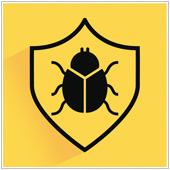| 5 Online security tips |
1. Use two-factor authentication whenever possibleTwo-factor authentication, or two-step authentication as it is also known, is the idea of using two pieces of information to log into accounts: Your usual password and a code that is usually sent to a mobile device or generated by a code generator. By utilizing this safety feature, you can further increase the security of your accounts, largely because the chances of someone getting their hands on both the generated code and your password are slim. Some sites don’t use a code and instead ask a question that needs to be answered every time you log in. If this is the case, make the question something that is difficult for a hacker to guess. For example, use your address from 10 years ago instead of your current address. 2. Audit who has access to what dataBetween all of your online accounts and social media profiles you will likely be surprised at just how much information about you can be found online. There are a multitude of scare stories online, where someone has had their accounts hacked and identity stolen, largely because they had left pertinent information online without even thinking about it. It is a good idea to audit what information you have online. This includes looking at the contact and personal information you have on social media profiles, account information, etc. Ideally, if it is not necessary information, then it shouldn’t be shared. As for social media profiles, make sure only the absolute basic personal information is online and limit who can see this information. 3. Watch what is posted on social mediaBecause of the nature of social media, we often feel the need to share our whole lives online. This can often lead to oversharing, and even sometimes oversharing of personal information. There are stories online of thieves monitoring social media for businesses posting about how they are going to be closed for a holiday, with all staff gone. Once a thief finds this information, they then break into the business without worrying about people being there. If you are going to share information online, be sure to limit the potentially sensitive information that you post, especially if the content is shared with the public. 4. Change your passwords regularlyIt seems like almost every week news breaks of a password or account information breach. What this translates to is the fact that your accounts are always facing a potential risk. Therefore, you should make it a habit to change your passwords on a regular basis. Most experts recommend at least once every three months, but if there is a breach where your account information may have been leaked then naturally change your passwords straightaway. To ensure maximum security, you should use a different password for each account, and keep these as separate as possible. 5. Work with an IT partner who can offer enhanced Internet securityEnsuring that your business is secure online can be an on-going battle that you will likely not win easily. One of the best steps to take is to work with an IT partner like us. We offer a variety of Internet security solutions that can help stop malware intrusions before they infect your systems, block access to potentially harmful sites, and even scan Internet-based email solutions. In other words, we can help improve your overall online security. If you are looking to learn more about how we can help your business be secure online, contact us today. Published with permission from TechAdvisory.org. Source.
|
| Layering calendars on Google Calendar |
|
| Analytics 101: Analytics Diagnostic tool |
|
| VoIP 101: QoS |
|
| Are you suffering from Shellshock? |
|
| 5 Common types of business apps |
|


 Any business with Internet-based systems should be taking the appropriate steps to ensure that their activities and information are secure from the ever-expanding number of online threats. This can be tough, especially for businesses who operate almost exclusively online. To help, here are five tips that can help keep your online activities safe from attacks.
Any business with Internet-based systems should be taking the appropriate steps to ensure that their activities and information are secure from the ever-expanding number of online threats. This can be tough, especially for businesses who operate almost exclusively online. To help, here are five tips that can help keep your online activities safe from attacks. There are a wide variety of tools business owners and managers rely on, on a daily basis. One of the most valuable is the calendar, or Google Calendar if you are a Google Apps user. This app offers users numerous features that are expected of digital calendars, and some features that aren’t. One such feature is the ability to layer multiple calendars from other users onto your own.
There are a wide variety of tools business owners and managers rely on, on a daily basis. One of the most valuable is the calendar, or Google Calendar if you are a Google Apps user. This app offers users numerous features that are expected of digital calendars, and some features that aren’t. One such feature is the ability to layer multiple calendars from other users onto your own. Google Analytics has become the most popular way for businesses of all sizes to track relevant website data like visitor information, clicks, links, etc. While this platform is useful, there is always the chance that it may not be configured properly, or your site may have data related weaknesses that inhibit useful data tracking. Luckily, Google has introduced a diagnostic tool to help.
Google Analytics has become the most popular way for businesses of all sizes to track relevant website data like visitor information, clicks, links, etc. While this platform is useful, there is always the chance that it may not be configured properly, or your site may have data related weaknesses that inhibit useful data tracking. Luckily, Google has introduced a diagnostic tool to help. There are a number of popular communication systems that a company can implement, with one of the most well know being VoIP. While VoIP is popular, there are a wide number of providers and services, and it can be difficult to know which one to choose. One factor you should look at when considering a new VoIP provider is their QoS, or Quality of Service.
There are a number of popular communication systems that a company can implement, with one of the most well know being VoIP. While VoIP is popular, there are a wide number of providers and services, and it can be difficult to know which one to choose. One factor you should look at when considering a new VoIP provider is their QoS, or Quality of Service. When first announced in April of 2014, Heartbleed was one of the biggest security issues ever uncovered. Companies scrambled to patch systems and ensure they were protected from this problem. While big news, there is a recently uncovered security flaw called Shellshock which could make Heartbleed look relatively small in comparison, and it is a potential problem you should be aware of.
When first announced in April of 2014, Heartbleed was one of the biggest security issues ever uncovered. Companies scrambled to patch systems and ensure they were protected from this problem. While big news, there is a recently uncovered security flaw called Shellshock which could make Heartbleed look relatively small in comparison, and it is a potential problem you should be aware of. Business has become a much more mobile affair, thanks largely in part to the various mobile devices and operating systems currently available. These systems all rely on apps to operate and there are a near limitless number of apps, that business users can benefit from. To help, here are five of the most common types of apps business users install on their devices.
Business has become a much more mobile affair, thanks largely in part to the various mobile devices and operating systems currently available. These systems all rely on apps to operate and there are a near limitless number of apps, that business users can benefit from. To help, here are five of the most common types of apps business users install on their devices.